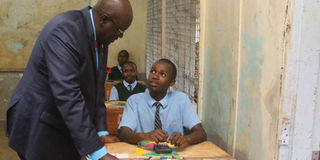Exam results call for reflection, not throwing blames at State

Kenya National Examinations Council chairman George Magoha speaks with a candidate at Murang'a High School before the start of a KCSE examination paper on November 6, 2017. Activist Okiya Omtatah wants the agency to release marked test papers. PHOTO | JOSEPH KANYI | NATION MEDIA GROUP
What you need to know:
- It is a godsend opportunity to ask ourselves whether we, as a nation, are doing justice to the children of Kenya.
- It is not that KCSE candidates started failing yesterday. The rain started beating them earlier than that.
Some stakeholders in the education sector have taken issue with the fact that the number of candidates with minimum university entry qualifications, C+ and above, is 70,073 (11.38 per cent) out of the 611,952 who sat for the 2017 KCSE examination.
They have every right to take issue with the dismal performance.
The performance in 2017, just like it was in 2016, is disquieting.
Students who got C+ and above in the 2016 were 88,929, representing only 15.41 per cent out of 574,125 candidates in 2016.
INTEGRITY
It is regrettable, however, that some stakeholders are attributing this tragic state of affairs to “a fraud that had condemned students to mass failure”.
They see an alleged determination by the government to force more students to join tertiary institutions.
Nothing can be further from the truth. There is nothing sinister in the KCSE examination results we are witnessing.
They are a true reflection of the quotient of energy and skill that has gone into curriculum management and delivery across the board.
The environment in which students prepare and sit examinations is designed to ensure that the integrity of the examining process is preserved.
EXAM MARKING
Aggregation of marks and other concomitant statistics are now electronically done, unlike in the past.
For many years, the marking of KCSE always ended by December 24.
But the results were released towards the end of February — a delay that was unnecessary and fraught with temptations.
The examination results provide facts and figures that inform the policy interventions needed to address the weakness revealed, or reinforce the strength.
Results provide an opportunity, for self-questioning or introspection.
It is a godsend opportunity to ask ourselves whether we, as a nation, are doing justice to the children of Kenya.
PERFORMANCE
The number of students who scored C+ and above oscillated around 30 per cent before the 2016 KCSE results, which plummeted in that year when only 15.41 per cent scored above C+.
Former Knec chairman Kabiru Kinyanjui was never satisfied with the 30 per cent mark.
In his speeches during the release of 2013 and 2014 KCSE results, Prof Kinyanjui challenged educational researchers to establish why there was such a dismal performance.
It is not that KCSE candidates started failing yesterday. The rain started beating them earlier than that.
Brickbats and recriminations will not help anybody, least of all, the students we are ostensibly fighting for.
Kennedy Buhere, communications officer, Ministry of Education, Science and Technology




